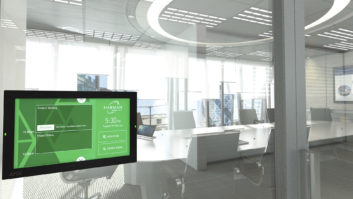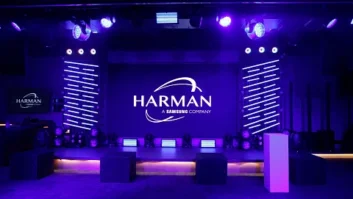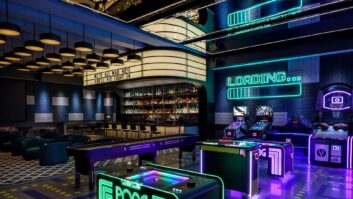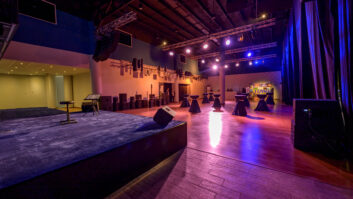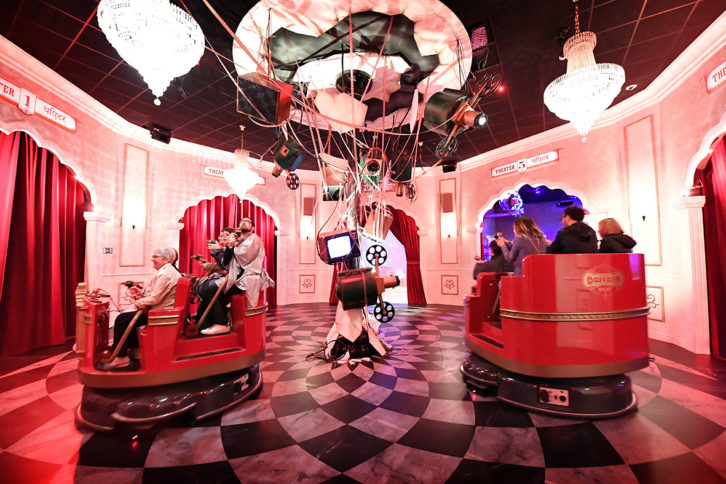
You find yourself in Queen’s Gardens in Townsville, Queensland. It’s July and, at six in the evening, Castle Hill – which dominates the city – springs to life in a multimedia show of enormous proportions. The park around you explodes into a riot of changing colour.
Or: you walk into a hotel. In the lobby, displays subtly respond to you passing – encouraging you to ‘play’ with them. There’s a virtual concierge: point at what you’re interested in, and sensors respond to your arm motion, delivering relevant content. As you walk along the elevator corridor, projected graphics react to your movement. You’re at the Renaissance Hotel in midtown Manhattan.
You’re on Concourse A at the Charlotte Douglas International Airport in North Carolina. As well as the usual wayfinding and digital signage, there’s a 140ft-display – showing a ‘data sculpture’ that turns the airport’s invisible patterns of data into an art form. The image is also shown on two screens near the departure gates – and from outside the terminal building.
Or perhaps you’re a student in a university lecture hall. You and everyone else can clearly see and hear the professor, who seems to operate the equipment effortlessly. Now, you’re in a huddle room. It’s a great meeting because everyone can seamlessly interact not only with those in the room but those on the other side of the world.
Creative use of technology
Welcome to the world of great experiences delivered by the creative use of audiovisual technology. ‘Experiences’ have always been what much of the AV world is about.
“Everything in our daily lives is an experience,” believes Thomas Walter, who is section manager, strategic product marketing at NEC Display Solutions Europe. “Listening to a professor in a university or to a business panel debate is an experience, as are going to a shopping mall or retail store, or travelling via the airport or train station. We have become desensitised as these activities become commonplace and routine and are therefore no longer considered to be an experience. Here, AV can reignite the appeal of these experiences, injecting something new, fascinating and engaging into what has become the mundane.”
“An AV experience is exceptional when content, space, and technology come together to deliver the outcome the customer wants”
Brad Grimes, AVIXA
Peter Pauwels, VP of sales, entertainment EMEA at Barco, develops the professor theme – and begins to articulate what a great experience should look like.
“In a university auditorium, the professor needs the audio and video to be heard,” he says. “The difference between a good experience and an optimum experience is the amount of the audience you capture. How do you assure that 99% of those present hear and see the message? How do you ensure everybody in a class or meeting interacts when they want to?”
Industry trade body AVIXA has, for some time now, been advocating precisely that – that AV is, above all, about creating great experiences – whatever the application or environment. It’s not just about the audiovisual spectaculars for which the industry has become rightly renowned – although those still represent AV technology at its most daring and compelling.
“It’s always been AVIXA’s belief that an AV experience is exceptional when content, space, and technology come together to deliver the outcome the customer wants,” says Brad Grimes, the organisation’s senior director of communications. “Sometimes, that outcome is making people go ‘wow!’ Other times, it’s greater productivity via online collaboration, or a better learning experience in a tech-enabled classroom. When we talk about great AV experiences, we’re not just talking about elaborate projection mapping or giant videowalls.”
“AV is finding its way into all types of experience – from retail and entertainment to family entertainment centres through to lobbies of corporate buildings and offices,” agrees Matt Barton, CEO of 7thSense Design, developer of the Delta Media Server range. “Across all experiences and spaces, there’s certainly a feeling that a ‘glowing rectangle’ is just not enough any more.”
Growing crossover
What’s interesting is the growing crossover between what might be termed corporate implementations of AV technology on the one hand, and the leisure and entertainment business on the other.
“Creating an experiential design has become the ‘in thing’ for many brands, corporate and retail venues and beyond,” notes Ross Magri, managing director of Sarner, who specialise in the design of a variety of visitor attractions, including theme parks and museum exhibitions – and brand experiences. “In recent years, we’ve seen how large corporate institutions are investing large sums of money to create immersive, experiential, technologically sophisticated spaces that work for both the visiting public and the employees of the business.”
“The great experiences in museums, projection mapping, corporate lobbies and so on are the ones that are best remembered,” adds Pauwels. “For example, the lobby of Comcast Philadelphia officially became a tourist attraction because of the experience.”
And, in the same way there is crossover in terms of environment, so too there is crossover in terms of what constitutes a great experience, and what doesn’t – whatever the application.
“Technology cannot be visible or noticed as this would take focus from guests away from the game and attraction,” believes Benoit Cornet, CEO and founder of Alterface, who create interactive dark rides.
www.7thsensedesign.com
www.alterface.com
www.avixa.org
www.nec-display-solutions.com
www.barco.com
www.sarner.com
